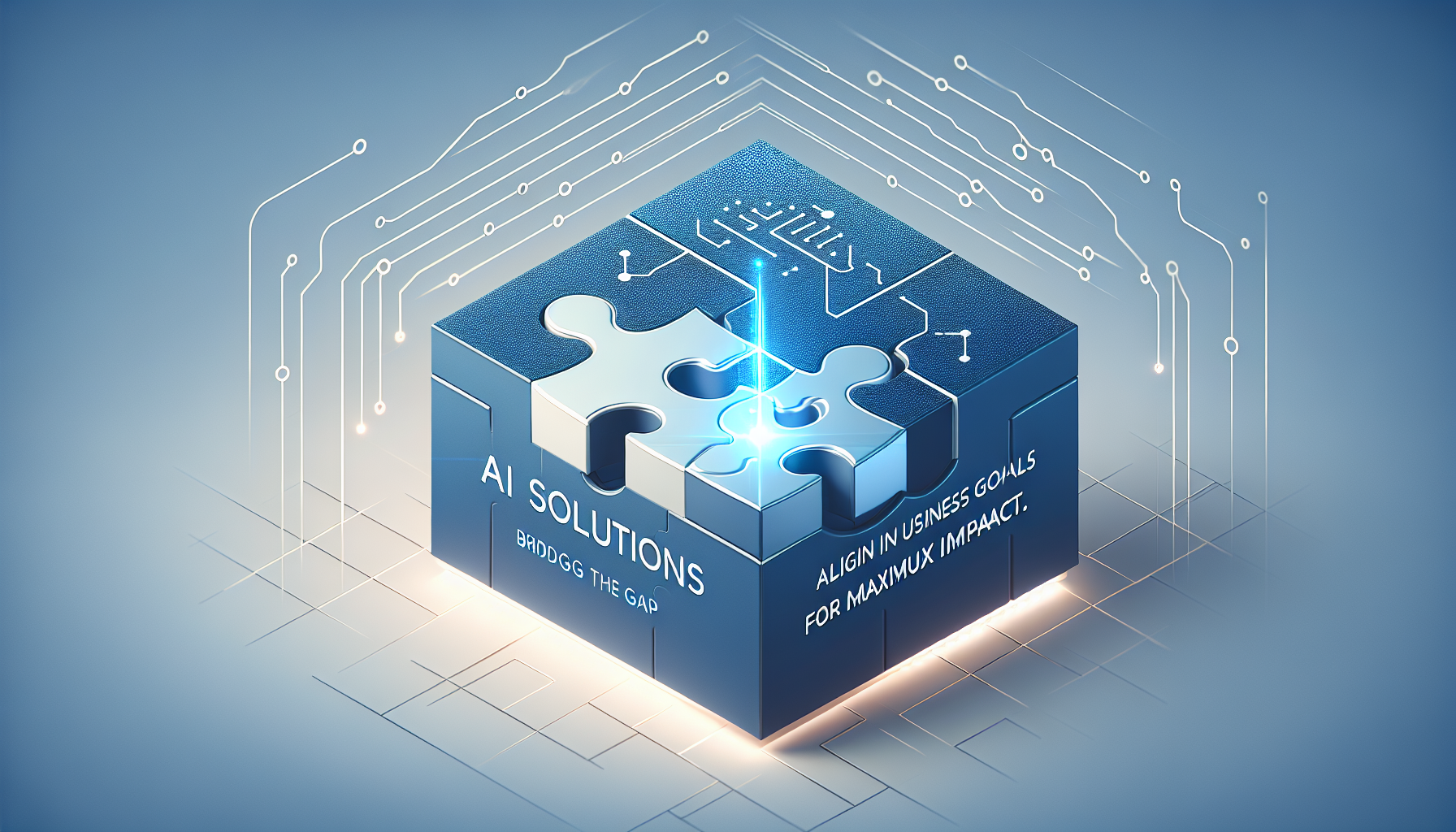Aligning AI Solutions with Business Goals: Unlocking Strategic Value
In the dynamic landscape of modern business, artificial intelligence (AI) has emerged as a transformative force capable of redefining operational frameworks and competitive positioning. Yet, the true power of AI lies not simply in its technological capabilities, but in how effectively it can be aligned with specific business goals to generate tangible value. Organizations often face the challenge of navigating the complex intersection between their strategic ambitions and the actionable AI solutions that can propel those ambitions into measurable outcomes.
Achieving this alignment demands a sharp analytical mindset combined with a holistic perspective—one that integrates the technological, human, and organizational dimensions into a cohesive strategy. To harness AI’s full potential requires a deliberate process of translating high-level business goals into clear operational objectives, which in turn inform the design, selection, and deployment of AI initiatives.
Clarifying Business Objectives to Shape AI Initiatives
Foundational to aligning AI solutions with business goals is a rigorous clarification of what the business aspires to achieve. Business goals span diverse domains such as revenue growth, market expansion, customer experience enhancement, operational efficiency, risk mitigation, and innovation acceleration. Each goal presents unique opportunities for AI application. For instance, a goal centered on improving customer experience might prioritize AI-driven personalization and predictive analytics, while operational efficiency could call for intelligent automation and process optimization.
This prioritization necessitates identifying key performance indicators (KPIs) that concretely reflect success in these domains. Without quantifiable metrics, AI efforts risk drifting into abstract technological pursuits disconnected from business realities. Clear KPIs enable continuous measurement and adjustment of AI initiatives, fostering an iterative process of refinement aligned with evolving business strategies.
Bridging the Gap: Translating Strategies into Actionable AI Solutions

The transition from strategic goals to actionable AI solutions hinges on translating broad objectives into specific use cases where AI technologies can deliver measurable impact. This demands a deep understanding of both business processes and AI capabilities.
A practical approach involves mapping existing workflows and identifying bottlenecks, inefficiencies, or decision points that could benefit from AI augmentation or automation. Collaboration between business leaders, data scientists, and operational teams is essential to ensure AI initiatives are grounded in operational realities and integrate smoothly with existing systems.
It is crucial to recognize that AI is not a monolithic technology but a suite of diverse techniques—machine learning, natural language processing, computer vision, robotic process automation, among others. Selecting the right AI modality depends on the nature of the problem and the desired business outcome. For example, machine learning models can enhance demand forecasting accuracy in supply chains, while natural language processing can power intelligent customer support bots that reduce response times and increase customer satisfaction.
Leveraging Data as a Strategic Asset
AI’s effectiveness is inseparable from the quality, quantity, and relevance of data it consumes. In aligning AI solutions with business goals, data strategy becomes a central pillar. Organizations must invest in building robust data infrastructures that facilitate seamless data collection, integration, cleansing, and governance.
A comprehensive data strategy positions data as a strategic asset enabling AI models to deliver insights that are reliable and actionable. For example, a financial services firm aiming to reduce fraud losses needs access to comprehensive transactional data alongside external data sources to train sophisticated AI detection algorithms. Data silos, inconsistent formats, or poor data quality undermine AI’s predictive accuracy and can lead to misguided business decisions.
Furthermore, data governance frameworks must ensure compliance with regulatory requirements and ethical standards. Responsible data stewardship reinforces trust, mitigates risks, and aligns AI initiatives with corporate values, enhancing long-term sustainability.
People-Centric AI Integration: Empowering Workforce Synergies
Successful AI alignment transcends technology and data—it requires a people-first approach that embraces the workforce as active collaborators rather than passive recipients of automation. Artificial intelligence, when thoughtfully integrated, can enhance employee productivity, creativity, and decision-making rather than supplant human roles.
For example, AI-powered intelligent assistants can relieve employees from routine tasks, enabling them to focus on strategic, creative, and complex activities that demand human judgment and empathy. This synergy enhances workforce engagement and drives innovation.
To foster this dynamic, organizations must invest in reskilling and upskilling initiatives, ensuring employees develop competencies to effectively collaborate with AI systems. Transparent communication about AI objectives and impacts builds trust and reduces resistance to change. Leadership commitment to human-centered AI integration creates an environment where AI acts as an enabler of human potential aligned with organizational goals.
Ethical Frameworks as a Foundation for Trustworthy AI Deployment
Aligning AI solutions with business goals is incomplete without embedding ethical considerations at every stage. The call for ethical AI deployment is not merely about regulatory compliance but about safeguarding reputation, fostering stakeholder trust, and ensuring sustainable impact.
AI systems influence decision-making processes that affect customers, employees, and society at large. Ensuring fairness, transparency, accountability, and privacy is paramount. For instance, biased training data can perpetuate discrimination in hiring algorithms, eroding organizational integrity and exposing legal liabilities.
Implementing ethical AI requires establishing governance mechanisms—such as ethics committees, audit trails, and impact assessments—that proactively identify and mitigate biases and unintended consequences. Prioritizing explainability enhances transparency, enabling users to understand AI decisions and build confidence.
These ethical guardrails must align with corporate social responsibility goals, reinforcing the narrative that AI-driven innovation and ethical stewardship are mutually reinforcing, not contradictory.
Iterative and Agile AI Strategy for Continuous Alignment
Business environments are dynamic, shaped by evolving markets, customer expectations, and technological advancements. AI strategies must therefore embrace agility, emphasizing iterative development cycles that incorporate ongoing feedback and measurable results.
Deploying AI is not a one-time event but an adaptive journey where business goals and AI capabilities co-evolve. Pilot projects and proof-of-concepts serve as learning laboratories, reducing risks and uncovering hidden opportunities. Rigorous post-deployment monitoring ensures AI solutions remain aligned with shifting strategic priorities and external conditions.
This iterative approach also supports scaling successful AI initiatives in a modular and cost-effective manner, maximizing return on investment while avoiding technological obsolescence.
The Holistic Imperative: Integrating AI into the Business Ecosystem
Holistic alignment transcends departmental silos to embed AI within the entire business ecosystem, encompassing customers, partners, suppliers, and regulatory bodies. Cross-functional collaboration ensures AI initiatives address systemic challenges rather than isolated problems.
For example, integrating AI-driven insights across marketing, operations, and finance functions enables coordinated decision-making that enhances agility and coherence. Partnerships with technology providers and academic institutions amplify innovation potential while sharing risks.
Moreover, aligning AI with global sustainability goals—such as reducing carbon footprints and resource consumption—can unlock new markets and solidify brand positioning, illustrating how AI-driven business goals can extend beyond immediate profit to broader societal impact.
Strategic Resource Alignment: Optimizing Investment for Maximum ROI
Effective AI deployment requires not only identifying the right technologies but also strategically allocating resources including talent, capital, and time. Investing in talent acquisition and development ensures the availability of in-house expertise crucial for customizing and maintaining AI systems.
Capital expenditures must balance experimental initiatives with scalable solutions aligned to core business objectives. Timeframes should be realistic, recognizing that impactful AI integration requires sustained commitment rather than episodic efforts.
Leveraging cloud computing and as-a-service AI platforms can optimize costs and accelerate deployment cycles, enabling organizations to remain nimble and focus resources on differentiating capabilities rather than infrastructure management.
Conclusion of Strategic Imperative
The successful alignment of AI solutions with business goals is a rigorous, multidimensional endeavor demanding analytical precision, cross-functional collaboration, and ethical stewardship. By systematically clarifying objectives, translating strategies into actionable AI initiatives, managing data as an invaluable asset, embracing people-centric integration, and embedding ethical frameworks, businesses can unlock AI’s transformative potential.
Organizations that adopt this holistic approach position themselves at the forefront of innovation, resilience, and competitive advantage, ensuring every AI-driven project is a tangible step closer to realizing strategic ambitions while empowering people and respecting societal values.



